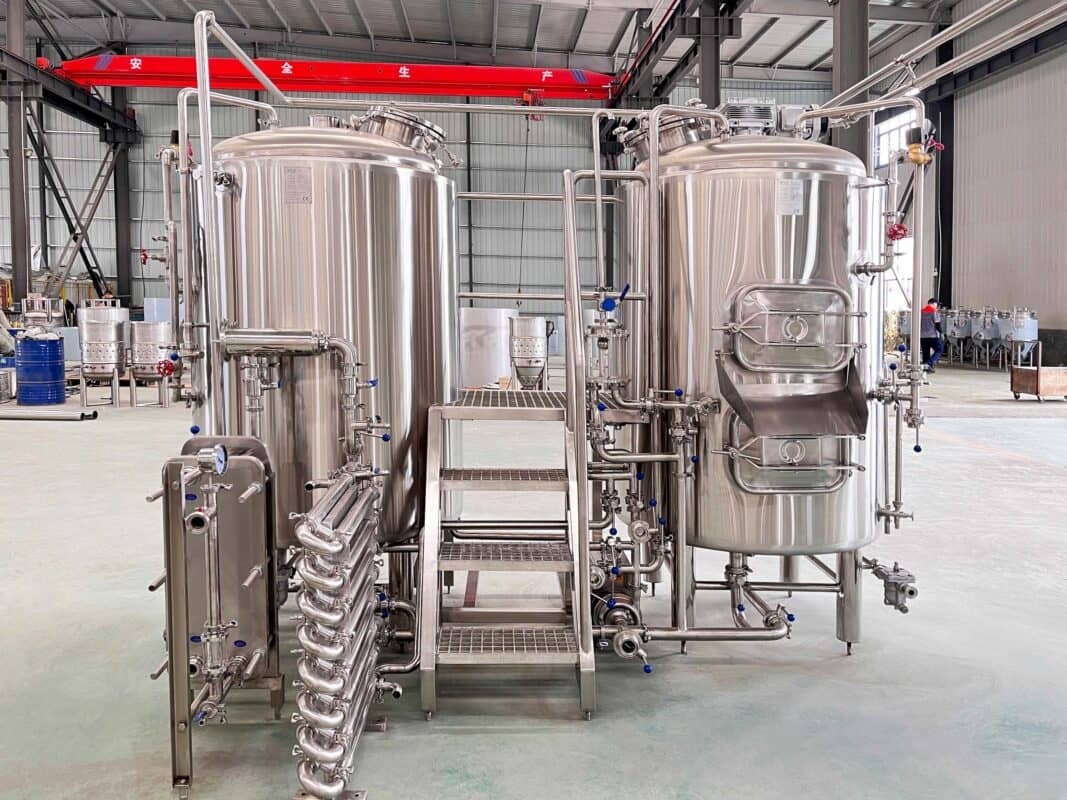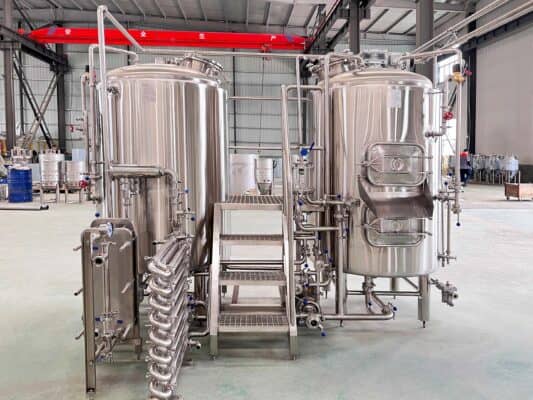alcohol brewing equipment requires specialized equipment to produce beers, wines, spirits, and other alcoholic beverages. This guide provides a summary of key equipment types, considerations for selecting and installing systems, and providers.
alcohol brewing equipment Types
| Equipment | Description |
|---|---|
| Brew kettles | Heated vessels for mashing grains and boiling wort. Available in stainless steel or copper. Sizes range from 5 to 20 barrels. |
| Fermentation tanks | Stainless steel or plastic tanks that allow controlled alcohol fermentation. Sized by batch volume, typically 10 to thousands of barrels. |
| Temperature control | Heating and cooling elements like glycol chillers to regulate tank temperatures. |
| Piping, valves, pumps | Hardware to transfer liquids, regulate flow, clean equipment. Manual or automated. |
| Process control | Sensors, automation equipment and software to monitor and control brewing. |
| Bottling/canning line | High-speed machinery fills/caps bottles or cans. Semi or fully automated. |
| Grain handling | Mills, conveyors & silos to deliver & process grain. Degree of automation varies. |
Customization Factors
Breweries have unique equipment needs based on production goals, budgets, staffing and space limitations. Key customization factors:
| Factor | Choices |
|---|---|
| Batch size | 5bbl systems to large industrial systems |
| Automation level | Manual equipment to fully automated brewhouses |
| Power options | Electric, gas or steam heating; glycol vs. direct expansion cooling; automation voltage |
| Materials | Stainless steel, copper, plastic – impact durability, maintenance, and flavor |
| Layout | Available space, workflow, ergonomics influence equipment footprint & positioning |
alcohol brewing equipment Suppliers and Costs
Many PROVIDERS offer brewing equipment sales, installation and maintenance. Prices vary widely based on features and customization.
| Company | Offerings | Price Range |
|---|---|---|
| Brewmation | Fully automated brewhouses | $100,000 to $2M+ |
| JV Northwest | Manual and automated systems | $50,000 to $750,000 |
| American Beer Equipment | Brew kettles, tanks, piping | $5,000 to $1M |
Factors influencing the price of alcohol brewing equipment
Whether you’re a weekend warrior whipping up a small batch of experimental pale ale or a seasoned distiller crafting award-winning whiskey, understanding the factors influencing the price of alcohol brewing equipment is crucial. The cost can vary wildly, from a few dozen dollars for a basic homebrew kit to hundreds of thousands (or even millions) for professional setups. So, what separates a budget-friendly bubbler from a top-of-the-line brewery behemoth? Let’s delve into the key cost drivers:
Scale and Ambition: This is the big one. The size and capacity of your equipment directly impact the price tag. A homebrew setup producing gallons at a time naturally costs less compared to a commercial brewery churning out kegs. Consider your needs – are you brewing for personal enjoyment or aiming for mass production?
Material Matters: Stainless steel reigns supreme in the world of brewing equipment. It’s durable, easy to clean, and imparts minimal flavor to your creations. However, it comes at a premium compared to options like plastic or food-grade buckets. Upgrading to features like double-walled insulation or specialized metals can further bump up the price.
Automation Adds Up: Manual systems require elbow grease, while automated ones take care of the heavy lifting (and heating, and cooling). While convenient, automation comes at a cost, with features like temperature control units and programmable fermentation cycles driving up the price tag.
Brand Prestige: Established brands with a reputation for quality and reliability often command higher prices. They may offer superior warranties, craftsmanship, and after-sales support, justifying the premium for some brewers. However, value-driven options from lesser-known brands can be just as effective.
Specialized Styles: Brewing specific types of alcohol like sours, kombucha, or spirits often requires unique equipment. Pressure cookers, specialized fermenters, and distillation columns add complexity and cost, catering to a niche market.
Location, Location, Location: Geography plays a surprising role. Importing equipment can incur additional costs due to shipping, taxes, and currency fluctuations. Local manufacturers or used equipment marketplaces can offer more budget-friendly options.
Remember, it’s an investment: While the initial cost might seem daunting, consider brewing equipment as an investment. High-quality tools can last for years, producing countless batches of your favorite beverages. Evaluate your long-term brewing goals and choose equipment that fits your budget and ambitions.
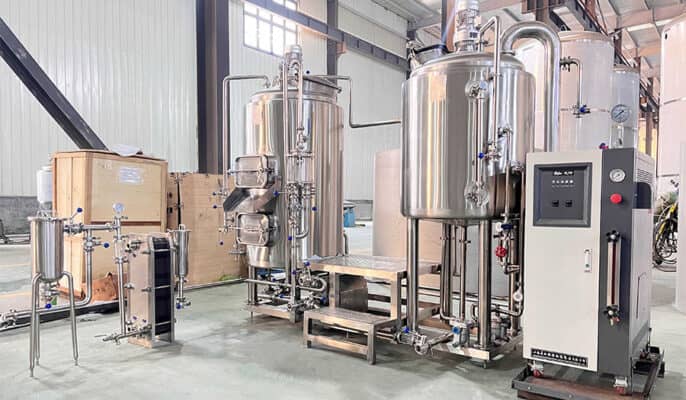
Purchase and Operation Considerations
Choosing an appropriate supplier and system requires evaluating many factors:
| Purchase Factors | Operational Factors |
|---|---|
| Equipment quality, reliability, warranty | Energy efficiency, operating costs |
| Company reputation and experience | Maintenance requirements |
| Customization capabilities, flexibility | Staff training needs |
| Budget | Cleaning procedures and chemicals |
| Lead time for manufacturing and delivery | Compliance with regulations, inspections |
Evaluation criteria will depend on individual brewery goals, finances and risk tolerance. Most aim optimize performance within budget constraints.
This overview covers common equipment in alcohol production facilities. Many variations and additions exist, like distillation systems for spirits or crushers for winemaking. Brewers can further customize with add-ons like quality control labs for testing alcohol content, flavor profiles and quality. With thoughtful selection and operation, brewing equipment enables efficient, consistent alcohol production at target volumes and costs.
Selecting the Right Fermentation Tanks
Fermentation tanks are a critical component for controlling the alcohol production process. Brewers must evaluate many factors when selecting tanks:
Tank Sizing
Tiny Titans: Perfect for the curious experimenter, 1-gallon jugs or carboys offer a compact and budget-friendly entry point. Ideal for testing new recipes or crafting personal-sized batches, they fit snugly in kitchens and apartments.
Weekend Warriors: Scaling up to 5-gallon carboys or kettles opens doors to more variety and sharing. This popular size caters to the casual brewer who enjoys sharing their creations with friends and family, offering enough volume for several six-packs without overwhelming your space.
Homebrew Heroes: Stepping into the 10-gallon territory signifies a commitment to the craft. This size allows for multiple smaller batches or larger, single-batch brews, catering to those who enjoy the process as much as the final product. Think weekly brewing sessions or supplying small gatherings.
Small-Scale Stars: For those dreaming of microbrewery-style production, 20-30 gallon kettles and fermenters offer a significant leap. This size caters to ambitious brewers who envision consistent production, supplying local markets, or hosting bigger events. Remember, space and cleaning demands also scale up!
Beyond the Norm: Pushing past the 30-gallon mark signifies serious business. These setups, often modular or stackable, cater to established brewers or aspiring entrepreneurs aiming for larger-scale production and distribution. Be prepared for dedicated brewing spaces and significant investments.
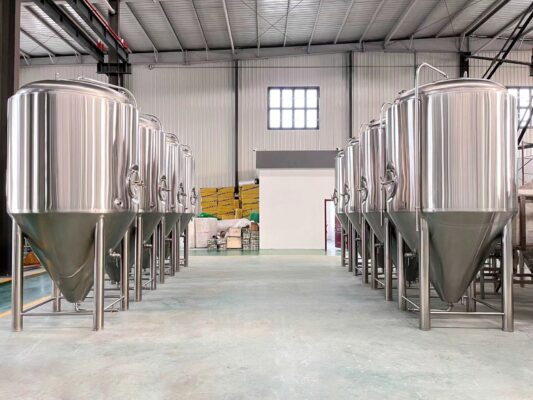
Tank Material
When it comes to choosing equipment for your alcohol brewing adventures, the tank material plays a crucial role in shaping your experience. Each option boasts unique advantages and drawbacks, and understanding them is key to making an informed decision. Let’s explore the most common contenders:
The King of Durability: Stainless Steel
Reigning supreme in the brewing world, stainless steel stands out for its exceptional durability, resistance to corrosion, and ease of cleaning. It imparts minimal flavor to your creations and withstands the rigors of sanitization and temperature shifts. However, its robustness comes at a premium, making it the pricier option.
Budget-Friendly Choice: Plastic
For cost-conscious brewers, plastic offers a more affordable alternative. Food-grade plastic containers and buckets are perfect for smaller-scale brewing or initial experimentation. However, some plastics can leach chemicals into your brew and might not withstand high temperatures as well as stainless steel. They are also more susceptible to scratches and staining.
The Traditional Touch: Wood
Wooden barrels infuse your creations with unique flavors and textures, adding a touch of history and character to your brews. Oak is the preferred choice for aging spirits like whiskey and cider, while other woods like cherry can complement specific beers. However, wood requires extensive maintenance, is prone to leaks, and can be challenging to clean, making it a niche option for dedicated enthusiasts.
The Glass Advantage: Clarity and Ease of Viewing
For visual observation and small-scale brewing, glass carboys offer undeniable benefits. You can directly witness the fermentation process unfolding, making them ideal for educational purposes or experimenting with new techniques. However, glass is fragile and requires careful handling, making it less suitable for larger setups or frequent use.
Beyond the Norm: Specialized Options
For specific brewing styles or unique needs, you might encounter more specialized materials like aluminum, copper, or even concrete. Each offers distinct advantages and limitations, tailored to specific applications. Researching their suitability for your chosen style is crucial.
Temperature Control
Simple Solutions for Casual Brewers:
For small-scale setups or those starting their brewing journey, basic methods like water baths or ice packs offer simple, budget-friendly options. While requiring more manual intervention, they can be effective for maintaining consistent temperatures, especially for styles with less stringent requirements.
Dialing it In: Immersion Chillers and Heating Elements:
These workhorses of temperature control directly interact with your brewing vessel. Immersion chillers use a coil submerged in your wort or fermenter to efficiently cool your brew, while heating elements provide precise temperature control during mashing or boiling. They offer more control than passive methods but require compatible equipment and some technical knowledge.
Automation Takes the Reins: Temperature Controllers:
Elevating your game? Consider a dedicated temperature controller. This handy device acts as the brain of your setup, monitoring and adjusting temperature based on pre-programmed settings. They often pair with immersion chillers or heating elements, automating the process and ensuring consistent results.
The All-in-One Approach: Fermentation Chambers:
For ultimate control and convenience, fermentation chambers take things to the next level. These insulated enclosures house your fermenters and provide precise temperature control, often with programmable profiles for different fermentation stages. While a substantial investment, they offer unparalleled control and consistency, ideal for serious brewers or those venturing into temperature-sensitive styles.
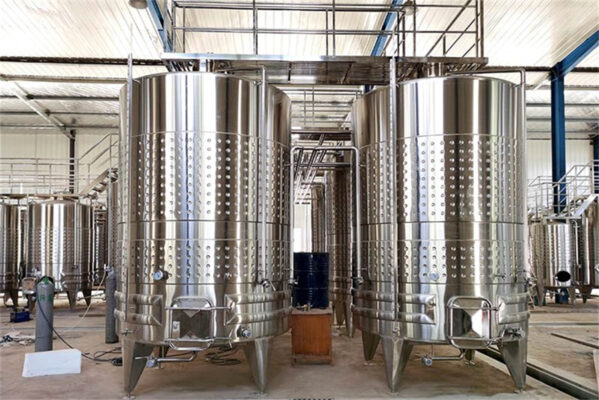
alcohol brewing equipment Cleaning and Maintenance
To maintain equipment and product quality, brewers follow stringent cleaning procedures between batches using clean-in-place (CIP) systems.
| Method | Function | Chemicals Used |
|---|---|---|
| Caustic wash | Removes organic residues | Sodium hydroxide, sodium hypochlorite |
| Acid wash | Eliminates scale & mineral deposits | Nitric, phosphoric or sulfuric acid |
| Sterilization | Kills bacteria | Isopropanol, hydrogen peroxide, ozone |
Daily and weekly maintenance checks also ensure proper operation:
- Inspect tanks and valves for leaks
- Verify temperature sensors and automation systems are well-calibrated
- Check pipeline and pumping systems flow as expected
- Review logs for analysis trends
- Test cleaning efficacy
Following best practices for cleaning and maintenance helps fermentation equipment consistently operate at peak performance for years.
FAQ
| Question | Answer |
|---|---|
| What is the most critical equipment for starting a microbrewery? | For small scale brewing, the key pieces are a brew kettle, fermenter tanks with temperature control, and bottling line. Grain handling and other automation can be added later if production increases. |
| What factors should I consider for equipment layout and space? | Consider equipment sizes, production workflow, ergonomics, ventilation, utilities access, and room to scale up or add tanks. Get layout advice from an equipment supplier or brewery consultant. |
| Should I choose automatic or manual equipment? | Automated brewhouses simplify operation for high volume facilities. Manual systems provide flexibility and hands-on control for smaller artisan brewers while costing less. Evaluate tradeoffs based on production goals, budget and staff capabilities. |




